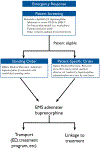Legal Authority for Emergency Medical Services to Increase Access to Buprenorphine Treatment for Opioid Use Disorder
- PMID: 33781607
- PMCID: PMC8238848
- DOI: 10.1016/j.annemergmed.2021.01.017
Legal Authority for Emergency Medical Services to Increase Access to Buprenorphine Treatment for Opioid Use Disorder
Abstract
Treatment with buprenorphine significantly reduces both all-cause and overdose mortality among individuals with opioid use disorder. Offering buprenorphine treatment to individuals who experience a nonfatal opioid overdose represents an opportunity to reduce opioid overdose fatalities. Although some emergency departments (EDs) initiate buprenorphine treatment, many individuals who experience an overdose either refuse transport to the ED or are transported to an ED that does not offer buprenorphine. Emergency medical services (EMS) professionals can help address this treatment gap. In this Concepts article, we describe the federal legal landscape that governs the ability of EMS professionals to administer buprenorphine treatment, and discuss state and local regulatory considerations relevant to this promising and emerging practice.
Copyright © 2021 American College of Emergency Physicians. Published by Elsevier Inc. All rights reserved.
Conflict of interest statement
Conflicts: None.
Figures


Comment in
-
Emergency Medical Services Buprenorphine: Just Because They Can?Ann Emerg Med. 2021 Jul;78(1):109-112. doi: 10.1016/j.annemergmed.2021.03.022. Ann Emerg Med. 2021. PMID: 34167727 No abstract available.
References
-
- Substance Abuse and Mental Health Services Administration. Key Substance Use and Mental Health Indicators in the United States: Results from the 2018 National Survey on Drug Use and Health. In. Rockville, MD2019.
Publication types
MeSH terms
Substances
Grants and funding
LinkOut - more resources
Full Text Sources
Other Literature Sources
Medical
Miscellaneous

